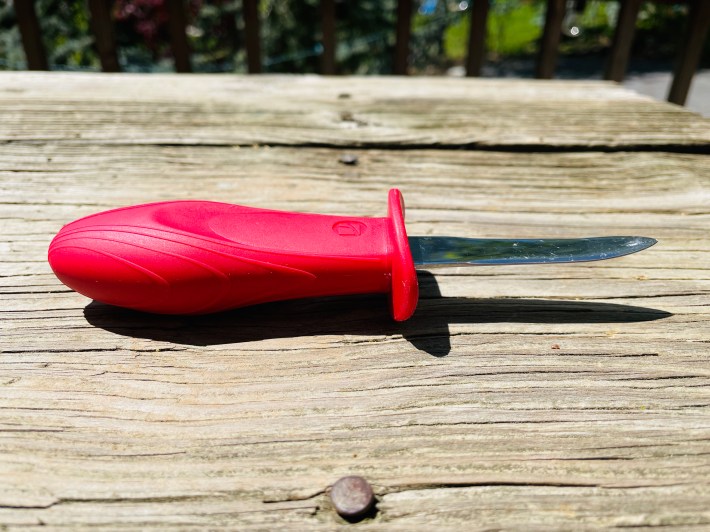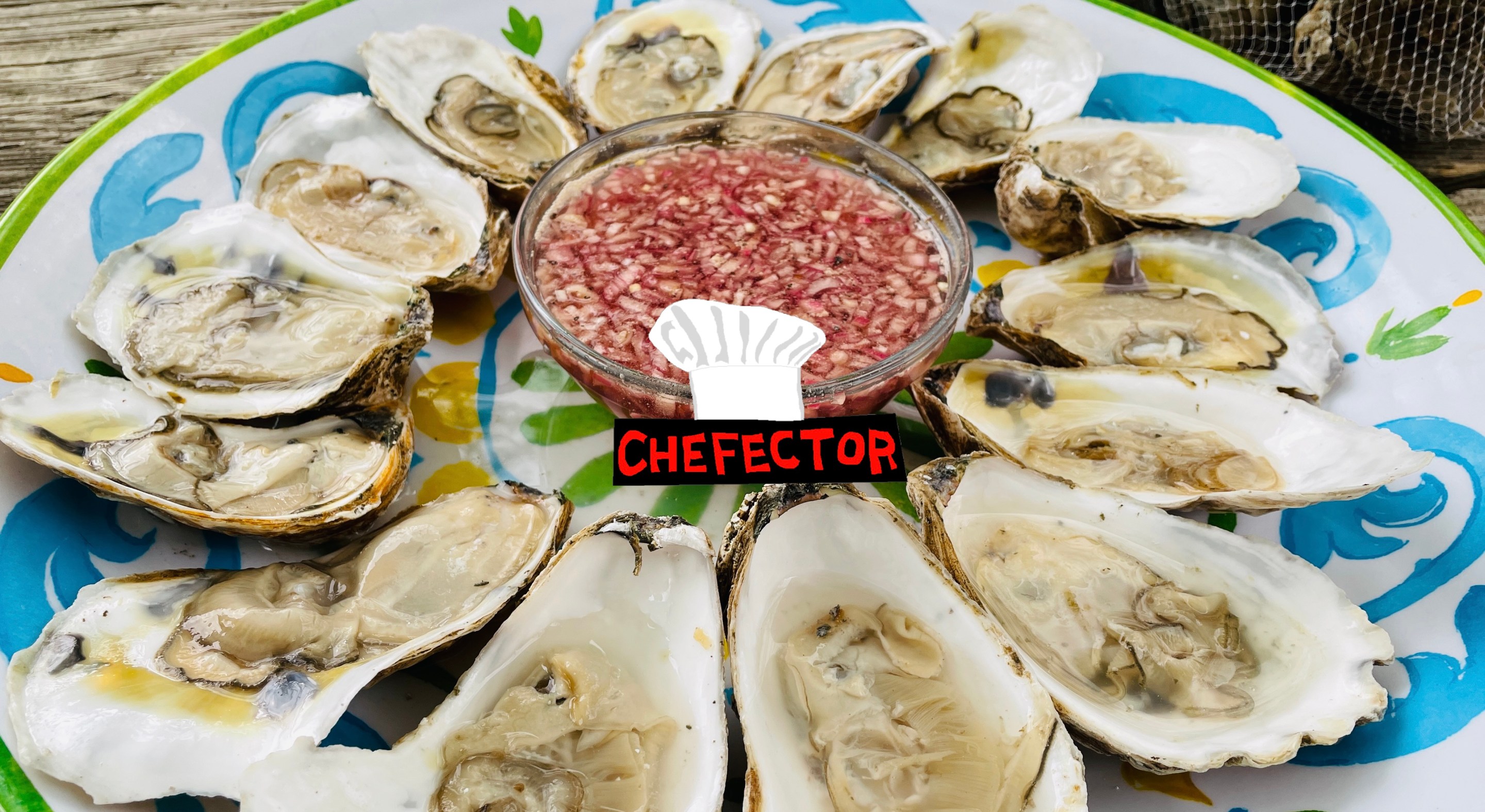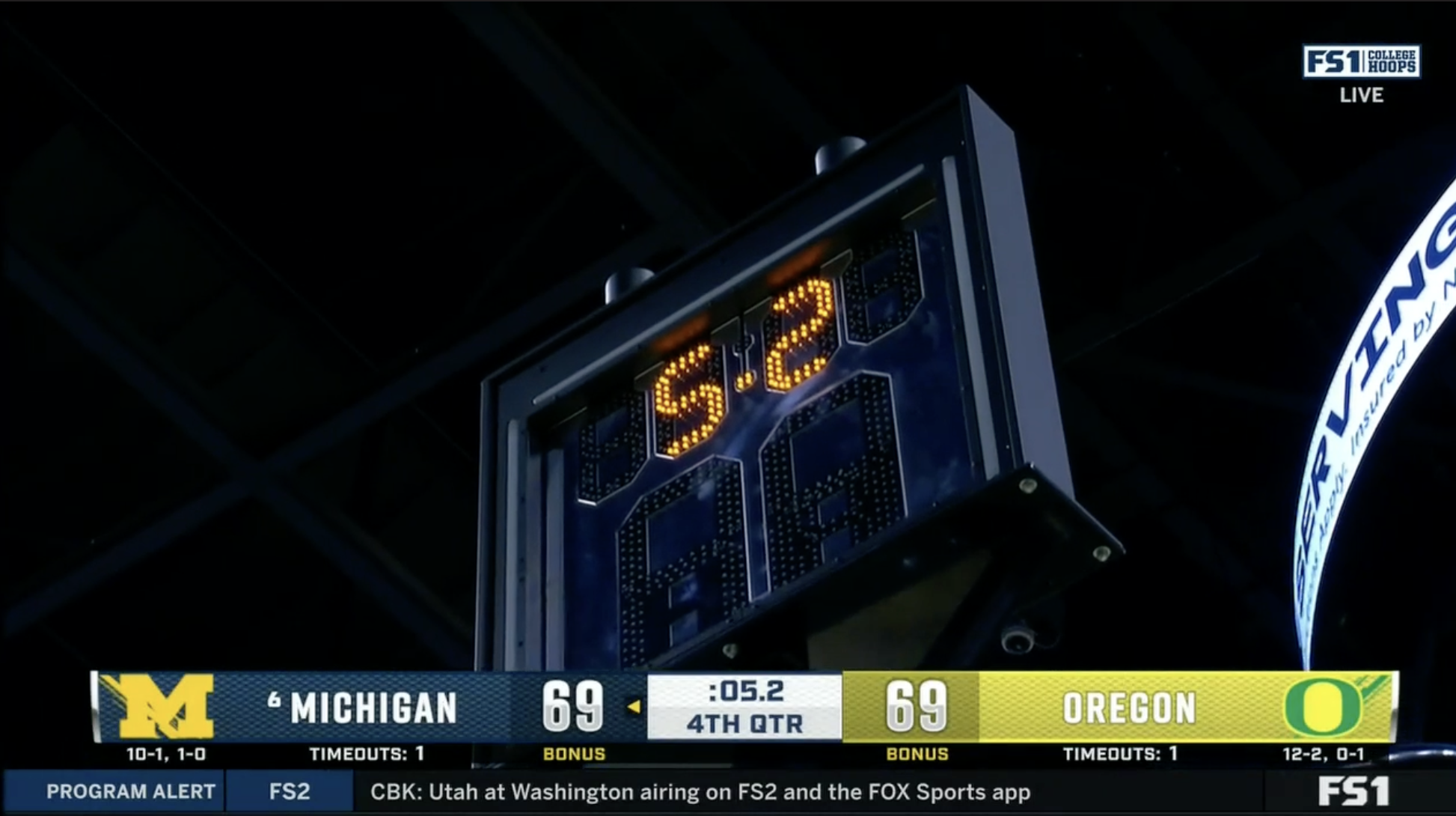I want you to shuck and eat some oysters. Theoretically they just went out of season, literally today, but I don't give a damn about that. It's bright and warm but not yet hot, and just about the best use you can make of bright spring warmth is to sit outside and shuck and eat some raw oysters in the sunshine. That's my plan for today, and so help me God you will join in, if only remotely, and that is all there is to that.
I've been on an oyster kick lately. Or an especially acute one, anyway, amid an adult life characterized in no small part by a persistent desire for oysters, more oysters, always more. Apart from being delicious (and, ugh, nutritious) and reasonably cheap and available, on top of their incredible power to transport your brain from wherever it is to a cold rocky coastline, they're also something to do in addition to being something to eat, a skill and a food at the same time. This is very appealing to me, given, well, all of this. Shucking oysters is a thing to work at, and get good at, and then your reward is that forever afterward it's easier to just eat oysters whenever you want (all the time!) than it was before. I heartily recommend it. In fact, I insist. Let's shuck and eat some oysters.
Here are some things you will need. Is one of them "oysters"? Continue reading to find out!
Let's do the non-food stuff first. (To sustain the suspense!) You will need an oyster knife. There are a few different kinds of oyster knife, and what all of them have in common is that they are not like other kinds of knife, and you cannot substitute another kind of knife for the job they do. They have short, stubby blades, for one thing, thinner at the tip and thick at the base, usually not more than two or three inches in length, so that there is less risk of the blade just snapping when you're attempting to pry open the hinge of an oyster shell with it. For another thing, oyster knives mostly do not have a truly sharp cutting edge, because there is no real need for one, because an oyster knife, properly used, never really does much of anything that would require one. Many good oyster knives have a shield at the top of the handle, where it meets the blade, to stop the knife from lurching too far forward when you're putting a lot of pressure on it and it finally slips into the oyster. And most oyster knives have a thick, short, rounded handle, not curvy and sexy like a chef's knife but just a dumb round bulb, because you're just going to clamp this sucker in a tight fist like the knob of a baseball bat.
Here is what my oyster knife looks like:

This, apparently, is what's called a New Haven–style oyster knife. It's distinguished from certain other styles of oyster knife by the slight upward bend of the last half-inch or so of the tip. This makes it handy for the pry-bar part of its job. My half-assed theory about the name, which I just now made up and which I do not care even one little bit to confirm or disprove or even learn about, is that this is what New Englanders came up with for an oyster knife because Atlantic coast oysters tend to have huge, thick, tough shells that require a little more prying action than some of the teeny little baby oysters they have in places like British Columbia. I don't give a damn if this true or not!
The point here is that you simply cannot shuck oysters, or anyway I absolutely will not countenance your attempts at shucking oysters, until you have gotten your hands on an oyster knife. The blade of a paring knife or steak knife or dinner knife is far too likely to snap—to literally break!—in the hinge of an oyster, an event that is ruinous to the project of shucking and eating some oysters at least and ludicrously dangerous at worst. And also all of those are puny weakling knives unsuited to the tough, brawny work of prying open many jagged ocean stones filled with delicious food. Whereas a chef's knife may be up to the job by some measure of metallurgic strength or whatever, but is a million times too large and you will mangle yourself or bend the blade of it. You simply must have an oyster knife! End of discussion!
I am going to say that you need a sturdy, tough glove, too. This will not be an absolute necessity by the time you've shucked the 500th oyster of your life, but for the first few dozen, you will need a glove for the hand that holds the oyster in place. Not a latex glove or a frickin' Isotoner—this is not for neatness, it is for safety—but a thick cut-resistant glove of the sort you'd wear for pulling weeds, or even one of these nutty chainmail mesh gloves that are purpose-built for stuff like butchery and oyster-shucking. The reason is very simple: It is very likely that at some point during your venture into oyster shucking, the knife is going to slip on the oyster shell and leap forward, toward your off-hand, the one that is holding very tightly onto the oyster. It is not a sharp knife! But it is still plenty pointy enough to gouge your hand painfully. Also the oyster shells, themselves, are hard and jagged and can give you scraps and nicks and shit. I will not be held responsible for your mangled Fire Marshall Bill hands!
We're also making mignonette sauce today, the tart and pretty and easy-to-make condiment that often goes with oysters, so that you will have the option of dressing your oysters with it. Mignonette can be made a few different ways, up and down a scale of fanciness. Today we're going for a straight-ahead, normal-ass version of mignonette; you will need, say, half a cup of red wine vinegar, a single normal-sized shallot that you will mince very finely, and some freshly cracked black or white pepper. Do not substitute powderized pepper in a jar, here; it will float on top of your mignonette and look weird and gross. You need peppercorns and a method of cracking them.
You will not need some lemons, but maybe you will like a spritz of freshly squeezed lemon juice on an oyster, in which case I really don't see how you can have that unless you have some lemons. If you're getting lemons, then I would recommend, say, half a lemon per dozen oysters. Only you know how many lemons that winds up being. Likewise, maybe you like some grated (or jarred) horseradish or some hot sauce, or some horseradish and hot sauce, on your oysters. I also like this, as a nice change of pace from totally undressed oysters. In that case it seems that you will need to have that stuff.
(Many sets of instructions for shucking oysters tell you that you need to plate them atop a bed of crushed ice. I think that is baloney. The ice doesn't accomplish any meaningful cooling in what certainly ought to be the very brief period of time between when you shuck your oysters and when you eat them; whoever heard of any significant amount of cold traveling upward, through a damn oyster shell, within a matter of a few minutes? Nobody, that is who. My hunch is that the utility of the crushed ice is that sorta hides what people might regard as the unsightly pool of grayish ocean water that may form on a plate beneath a bunch of shucked raw oysters. Well to hell with that, I say!)
Lastly, you will need ... some oysters. About that.
Broadly, unless you have some method of accessing oysters from, like, overseas, it's helpful to go ahead and break up the selection of raw oysters into a few different categories. There are Pacific Northwest oysters, which tend to be relatively small compared to their Atlantic brethren, and which generally taste sweeter and less sharply briny; they're thought to be the most approachable oysters for anybody who's new to, or nervous about, eating them raw. There are Atlantic oysters, which tend to come from northerly parts of the East Coast (though it's easier now to get them from mid-Atlantic places than it was a few years ago) and tend to have big, thick shells with big, fat oysters inside of them, and which at the extreme end are spectacularly briny, right up to tasting almost exactly like a mouthful of ocean water. I say that as a recommendation: A couple of weeks ago a Katama Bay oyster, farmed in deep waters amid ocean currents, transported me instantaneously to the Atlantic Ocean, where I haven't been able to go in three tough years, very specifically to the treasured experience of being clobbered and rolled by a big wave and coming up spluttering with a nose full of ocean and having just enough time to yell out a Ric Flair "WOOOOOOO" before the next one, and I actually had to fight back tears at the sudden breathtaking nearness of it.
Ah, right, and then there is the third category, which is intense Floridian partisans who insist that oysters from their state's Apalachicola Bay are the sweetest and best to be found anywhere. Unfortunately the oyster population there is dwindling rapidly due to human society stuff causing the water to become saltier, so forget about these.
You'll likely be constrained a bit in your oyster selection by where you are, at least if you want to have oysters today. If you're here on the East Coast, finding some raw Atlantic oysters very probably is as straightforward as finding the nearest place that sells fresh seafood, like a dedicated fish market or slightly fancy supermarket, e.g. Wegmans or, like, Whole Foods or whatever. If you want Pacific oysters, you may have to do a bit of hunting around and/or ordering them online. Naturally, it's the other way around if you're out west. And this is maybe a subject for another blog but, where possible, buy farmed oysters: Modern oyster farming is generally thought to be more sustainable and environmentally benign than other forms of ocean harvest or aquaculture; oysters are an important part of the marine ecosystem and oyster farming supports the growth of their populations; farmed oysters are every bit as delicious as wild ones; and it's good to support the work of farming them.
As for how many oysters to get, here you must Know Yourself. If someone continually places plates of shucked oysters before me, for example, and these oysters are free of charge, then I simply will continue eating them until such time as I have died. On the other hand, if I have to purchase the oysters (usually between a buck and $1.50 apiece where I live) and shuck them myself, then I can content myself with sharing as few as a modest dozen with the one of my kids who reliably will want to have a few. I find that my enthusiasm for shucking typically peters out by the end of the third or fourth dozen, in any case. What I am saying here is get however many dang oysters you want.
Oysters keep incredibly well, relative to other living bivalves; it's fine to buy some oysters on Thursday and plan on eating them on Sunday, so long as in the meantime you can keep them in a chilly fridge or cooler, with, say, a couple layers of damp paper towel over them. What you shouldn't do is keep them in a sealed plastic bag; they do, in fact, benefit from some exposure to oxygen.
That is the last I have to say about getting oysters. Let's shuck them and eat them!
Or, well, OK, hang on a second. Let's make mignonette first, because that's super easy and because it'll benefit from the time its components can hang out together while you wrestle to open the oysters. Literally just combine that half-cup of red wine vinegar, in a little bowl, with the minced shallot and, oh, let's say around a tablespoon of the freshly cracked pepper. That's it. You can do this like a day ahead of time if you like, and keep it covered in the fridge, though I really don't know how much time you will have saved that way, given that it takes like 30 seconds to assemble, at most.
Let's shuck some damn oysters! Put your glove on your off-hand. Ready? OK.
Grasp an oyster in your off-hand and look down at it. A horror. A jagged nightmare stone from the cold depths. That's not the point. You will see that in a general sort of way it is kind of interpretively fan-shaped. Yes? It has a wider, flatter end, and then it has a narrower, probably thicker end. The wider end is the end that opens when the oyster eats or (presumably) gossips with the other oysters. The narrower end is where you will find the hinge of the oyster, the place where the two halves of the shell are connected. Peek around at this end and you'll spot it: a place amid all the wrinkles and ridges of the shell, often but not always demarcated by a bunching on both sides and a black line in the middle, where the two shells connect. This is the hinge. The hinge is where you are going to pry this sucker open.
For this first oyster, and probably for many others, I am going to recommend that, instead of grasping the oyster in your off-hand, you lay out a bath towel (mostly for traction, but also to absorb liquids) on a tabletop, place the oyster on it, and use your gloved off-hand to press down on the oyster and hold it very firmly in place, with the hinge pointed toward your mighty Knife Hand. Here is where the typical set of oyster-shucking instructions says something like "Insert the blade into the hinge of the oyster and rotate slowly but forcefully until you feel a slight pop." In the absolute broadest, most useless and discouraging sense, this is right: The goal is, indeed, to insert the knife into the hinge and then rotate it until the hinge pops open. But your first experience of it is not going to be anything at all like the impression you'd get from being told merely to "insert the blade into the hinge of the oyster." The thing is, the hinge is not really an opening; it is in fact an all-but-perfectly airtight seal between two extremely hard surfaces designed by nature to fit against each other perfectly. It does not exist for the purpose of permitting knives to be slipped into it; in fact, it exists for the exact purpose of keeping the two sides of the shell attached to each other. It is not accommodating of your oyster knife! The "insert" part of this is a gigantic pain in the ass, at first. (Do not even get me started on the instructions that use the word "slip" to describe how you get the knife in there. Their authors belong in the absolute bottommost pit of hell.)
So here is what you're going to do. With the handle of the oyster knife firmly gripped in your fist, and your off-hand pressing the oyster down on the towel very hard, press the tip of the knife against the hinge. What you are going to do is, with steady but not violent force, you are going to press and kinda wiggle and vibrate the tip of the knife against the hinge, like you're trying to fit it into a very tiny crack in a very hard rock, because that is in fact exactly what you are doing. The knife is going to slip, at least once. You are going to grunt and curse, and possibly you are even going to say some things like "What the fuck" and "I truly don't get this" and "I feel like I'm just trying to stab a knife into a rock right now." It's going to be annoying. You're going to get angry, at the oyster and at me and at yourself for allowing yourself to get talked into this. That is all fine, so long as you just keep at it.
Resist the urge to get more violent with your movements, or to try for one big forceful push that you imagine will defeat the hinge once and for all. It's not that kind of project: This is about persistence, about steady pressure and insistent wiggling. It involves force but isn't dependent upon it; it is dependent upon determination. The tip of the knife will appear to have dug into the hinge by a millimeter or two, and you will be filled instantly with the urge to switch to a prying lever-type motion, but it's too soon for that; the knife will pop right back out and you will want to fling it into a forest. Just keep pressing and wiggling and vibrating, steadily and patiently. Ooooh, oh, there, there it goes! The tip of the knife is now clearly inside the hinge, inside the shell of the oyster. Yes! Now you can, with more of that steady, non-explosive force, rotate your knife wrist slowly, until you feel a slight suction-y pop; that was the hinge being defeated for all time. You did it! You completed the most annoying part of shucking an oyster, by far.
The next bit is far less annoying, but still pretty awkward. You have to sever the adductor muscle, that holds the oyster shell shut. There are different ways to do this; for a beginner, angle the blade of the knife upward, so that it's pressing against the top of the inside of the shell, rotate the oyster like a plate, 90 degrees, and slide the knife along the seal between the top and bottom of the shell from the hinge end all the way to the other end. If it seems to snag anywhere along the way, you can do another version of the little wrist-rotation move that defeated the hinge. By the time you're done with this, you should be able to remove the top half of the shell. You can go ahead and expect that with this first oyster, the oyster itself may well be screwed up a little in there; parts of it may stay with the top half of the shell when you separate them. It's fine! You're doing great. You'll only get better at it.
Now, with the top half of the shell removed, you can do another version of that last move, along the underside of the oyster itself, to fully detach it from the shell so that it can just be slurped out of there. Or you can not do that, and plan on, like, having to kind of yank the oyster out of there with a fork later. I prefer the slurping! I recommend the slurping. But I am not standing behind you with a harpoon gun pointed at your back (yet) so you can do as you like.
I know I have used these words a lot over the past few paragraphs, but the key thing is steady, restrained, non-explosive force with all of these movements. No acute, violent exertions; that's how the knife slips, or how a big shard of shell cracks off before the hinge relents (a real bummer), or how the freshly opened oyster gets tipped so far that all of its precious liqueur (the briny ocean water stored inside the shell) all gets dumped out, or how you end up with an oyster knife sticking out of your wrist. Moreover that's just not how an oyster gets shucked. If you've ever done this before, imagine the kind of restrained but steady application of force you have to use when you're trying to loosen a badly stripped screw with a screwdriver: You know that if you bear down with sudden, acute force, the screwdriver is going to slip out (or further strip the head of the screw); you know that if you don't bear down at all, the screw won't turn. So you bear down and turn, slowly, insistently, and there it goes, it turns a little, and a little more, and then it's loose. Like that.
Shucking an oyster wasn't so bad, was it? And it only took, what, a couple thousand words or so. Now all you have to do is all the rest of the oysters. Let's catch back up when you're done.
There's nothing much to this next part, if you will simply put the oyster knife down and stop offering to shuck the top of my head off. Arrange the oysters around your prettiest plate. Put that little bowl of mignonette in the middle. Array lemon wedges and, like, little seafood forks around, if you're using that stuff. Find a nice sunny spot and a nice cold beverage. Lift an oyster to your face, and send your senses to the ocean, in lieu of yourself.







